These strawberry fruit leathers are easy to make. They require only a few ingredients, take only a few minutes to prep, and you don’t even need to do any cooking.
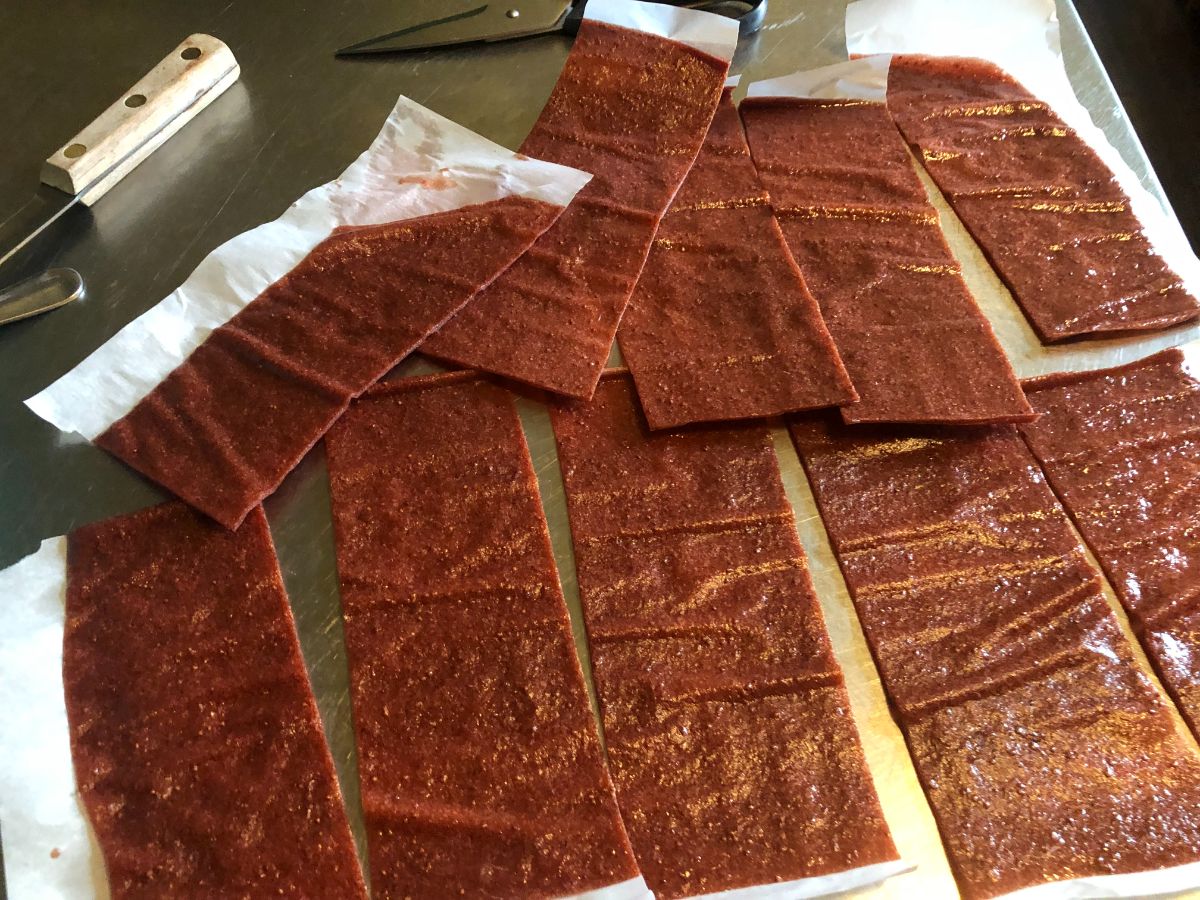
You can make these no-cook strawberry fruit leathers from fresh or frozen fruit. In fact, they may be even easier to make from previously frozen strawberries—so they’re a great way to use those berries you’ve put away. We’ve included instructions for working from both fresh and frozen strawberries, and we’ve included a cooked puree option if that’s what you prefer.
You won’t need much for equipment to make these fruit leathers. A blender or food processor, a few kitchen utensils, and parchment paper or silicone lining sheets are all you’ll need. They are easiest to make in a dehydrator, but if you don’t have one, you can use your oven, too.
Here’s how to do it:
Jump to:
- Ingredients
- No-Cook Strawberry Fruit Leather Step-by-Step Instructions
- Prep Your Strawberries
- Make the Strawberry Puree
- Blended Raw Strawberry Puree
- Cooked Puree Instructions
- Spread the Puree onto Liners
- Dehydrate the Strawberry Puree
- In a dehydrator:
- In the oven:
- Cool and Store Your Strawberry Fruit Leathers
- How to Tell When Your Strawberry Fruit Leather is Done Drying
- Other Flavors You Can Combine with Strawberries in Fruit Leather
- Summarized Strawberry Fruit Leather Recipe:
- Homemade Strawberry Fruit Leather Recipe
Ingredients
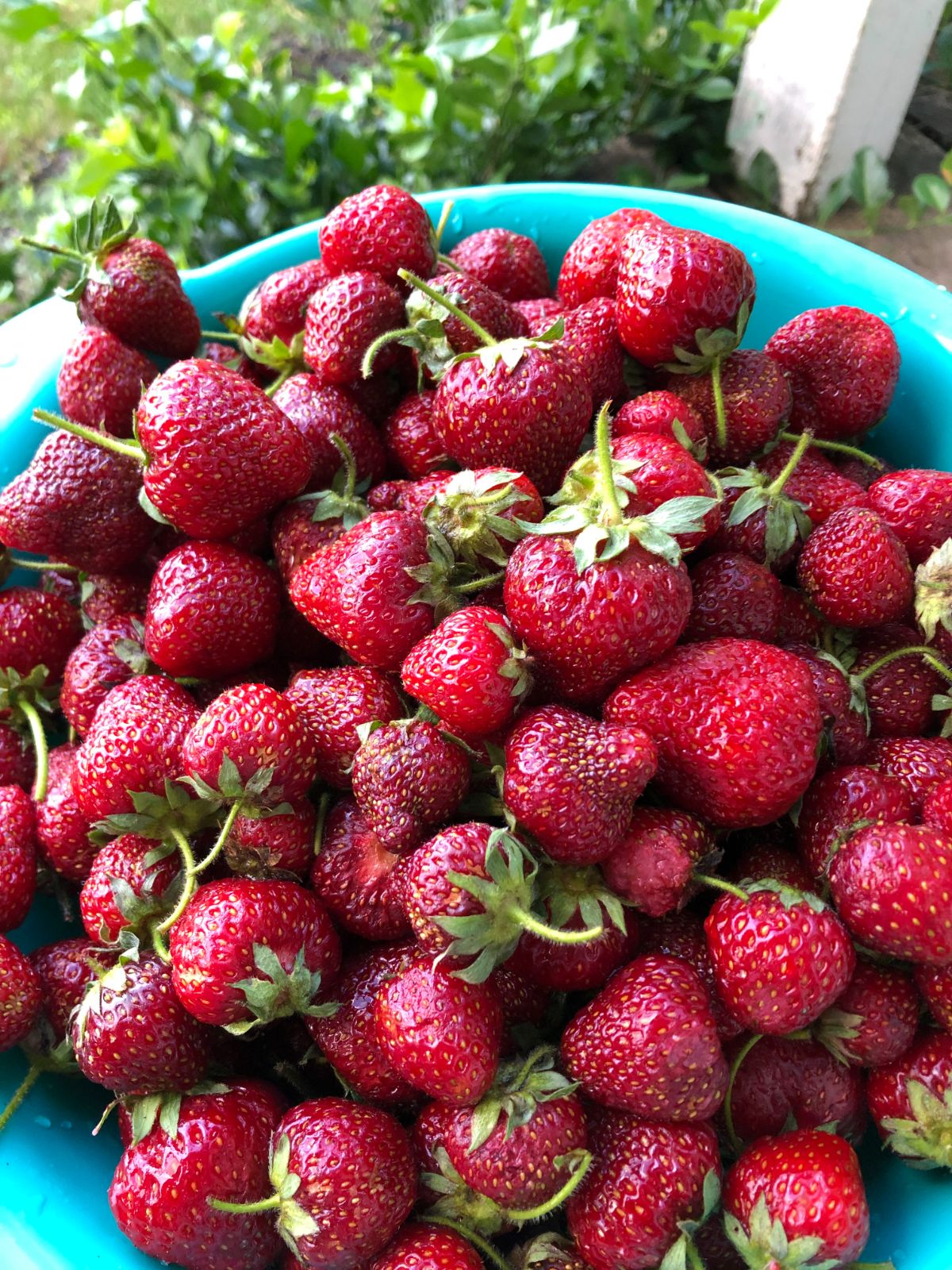
- 4 cups fresh or frozen strawberries
- ½ cup sugar* or honey; use more or less to taste**
- 1-2 tablespoons lemon juice (optional—adds acidity that supports flavors and is an added protection in storage against pathogens, color loss, and flavor loss, but is not necessary)
- Non-stick cooking spray for spraying liners and sheets (do not use spray with added flour; use a flavorless light cooking oil spray)
*Sugar is optional. It is used only as a flavoring and sweetener. If you don’t like added sugar or have dietary reasons to restrict your sugar intake, you can leave the sugar out. Strawberries do concentrate in flavor and sweetness while they dry, so leaving out the sugar is often of little or no account.
**Strawberries, like any fruit, can vary in sweetness, so it’s best to start low and add more sugar. Taste a berry before you start, and if it is very sweet, cut back on the sugar. If berries are tart or bland in flavor, you’ll probably need more sugar. Taste the puree before you spread it on the liners and adjust if needed. Keep in mind that the flavors will concentrate as the strawberry leather dries, so err on the side of under-sweet rather than over-sweet.
No-Cook Strawberry Fruit Leather Step-by-Step Instructions

Prep Your Strawberries
First, you’ll need to prep your berries.
If you are using fresh strawberries:
- Wash fresh strawberries under cold running water. Lay out on a kitchen towel or paper towels and pat dry to remove excess water.
- Trim the tops off the strawberries. Cut the berries into halves or quarters, so they blend and puree more easily.
If you are using frozen strawberries:
- Take the strawberries out of the freezer several hours ahead of time or the night before (and thaw in the refrigerator).
- Let the strawberries thaw completely. Drain off any water and juices that are released.
Make the Strawberry Puree
With the strawberries prepped (whether fresh or frozen), move on to making the puree.
Blended Raw Strawberry Puree
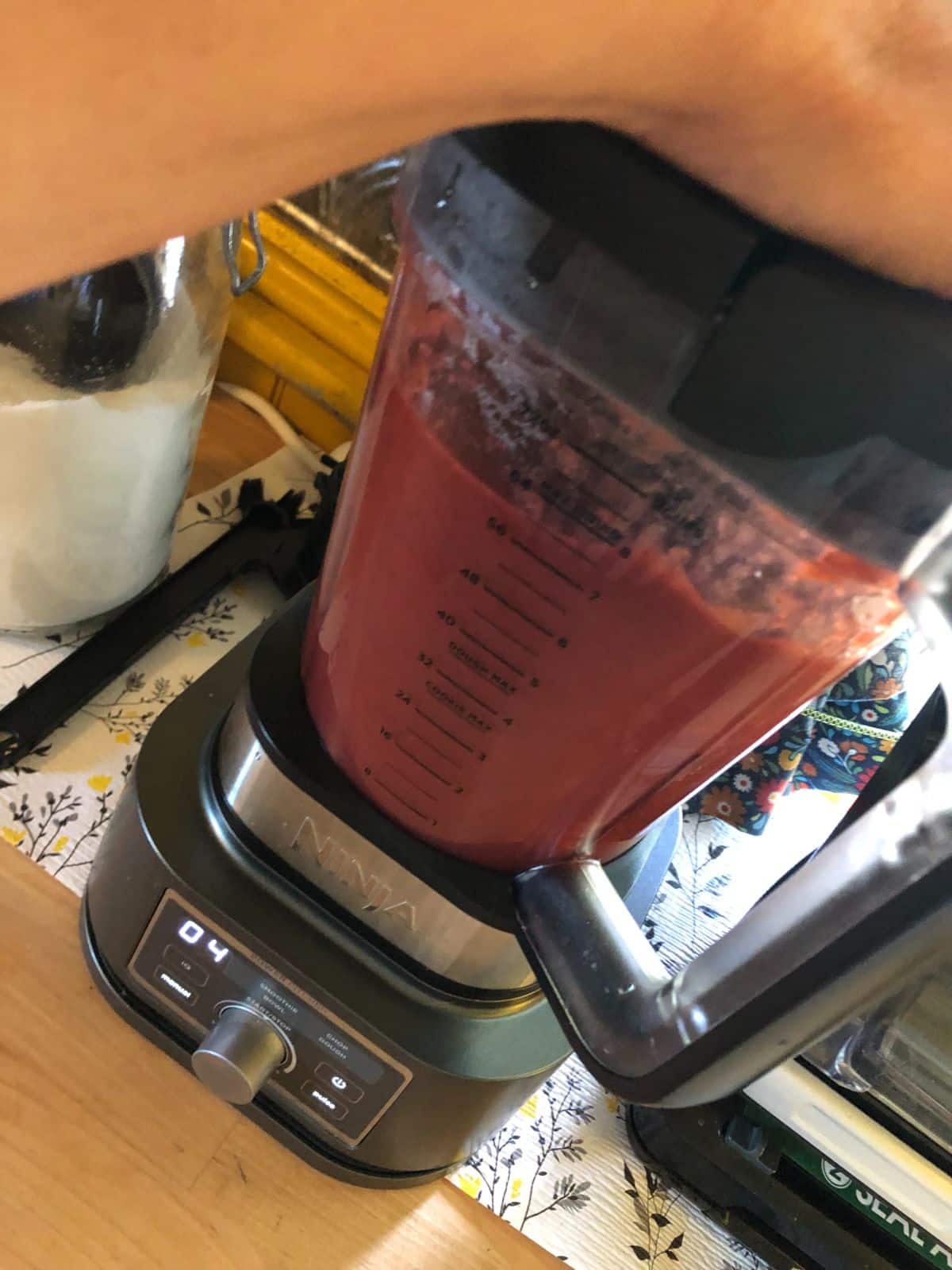
All you need to do is blend the berries until they are all pureed. The mixture should be smooth and uniform. It will be about the consistency of tomato sauce but perhaps a little thinner.
- Put prepped strawberries into a blender or food processor. Depending on your equipment, you may want to work in batches.
- Blend to puree until smooth and uniform
- Add the sugar and blend until evenly combined
Cooked Puree Instructions
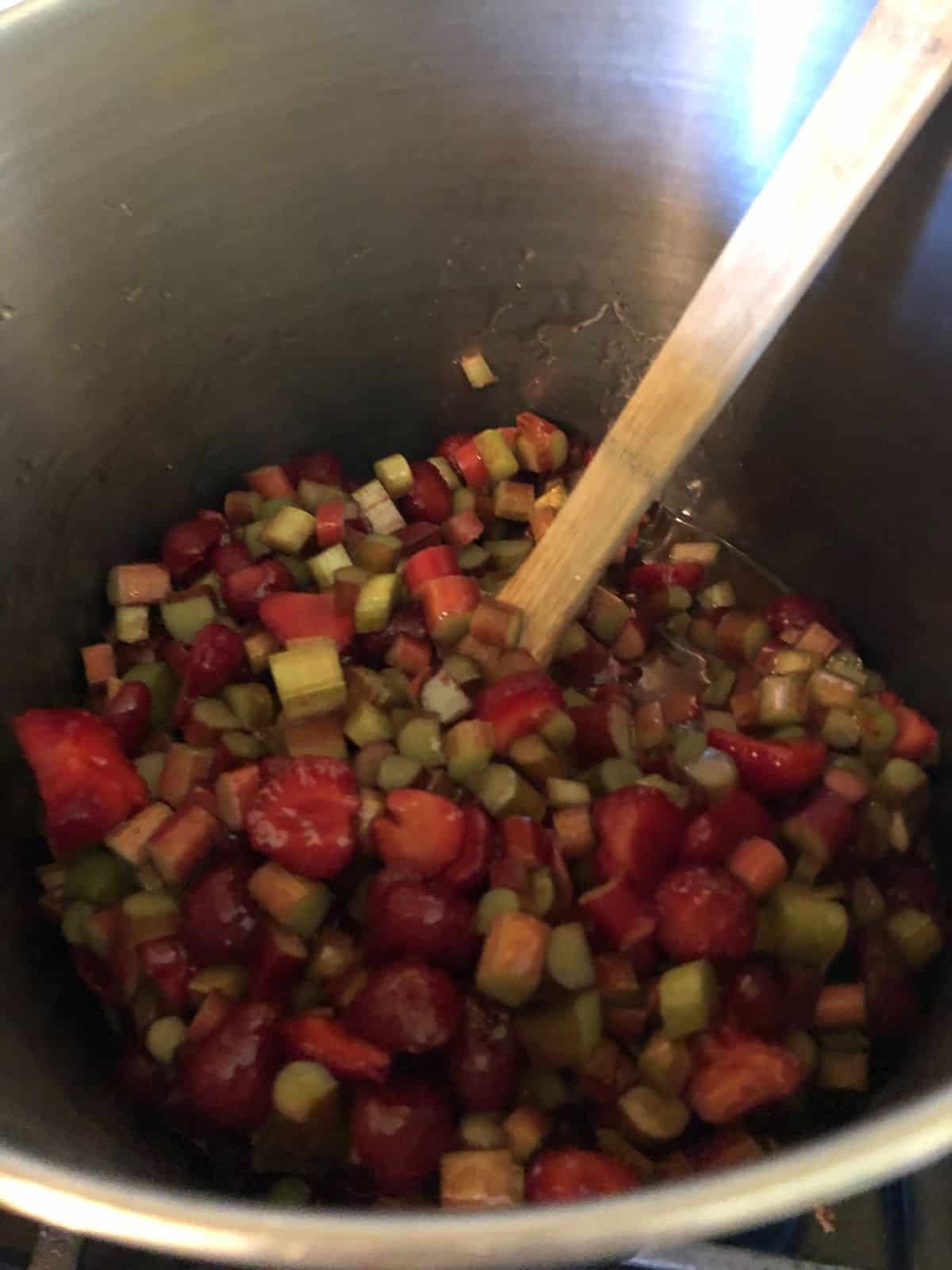
It’s not necessary to cook the puree when making these fruit leathers. You might prefer not to because any time you cook fruit or vegetables unnecessarily, you unnecessarily break down things like vitamins and antioxidants.
A reason that you might want to cook the strawberry puree is if you find the sugar is not dissolving well into your pureed berries.
Another reason would be if you are adding in a second, more fibrous ingredient that won’t break down with a simple blending and pureeing (see the notes on strawberry-rhubarb fruit leather below.
One other thing that cooking the puree does is steam off some of the water in the puree, which will thicken the puree and can reduce drying time.
Lastly, cooking to heat of boiling or simmering is a way to reduce mold spores or pathogens, though the process of dehydration is good at overcoming these things. It denies them the ability to grow and cause problems because it strips the water that these pathogens need to live (this is why dehydrating is a good method of preservation, to begin with). The acid in the strawberries is a protectant, too.
If you choose to cook your puree:
- Blend the strawberries until they are smooth, then transfer them into a non-reactive saucepan (stainless steel works best)
- Add the sugar to the pureed berries
- Cook over medium heat until simmering
- Simmer for 10 minutes, stirring frequently
- Let cool for several minutes, then spread onto liners
Spread the Puree onto Liners
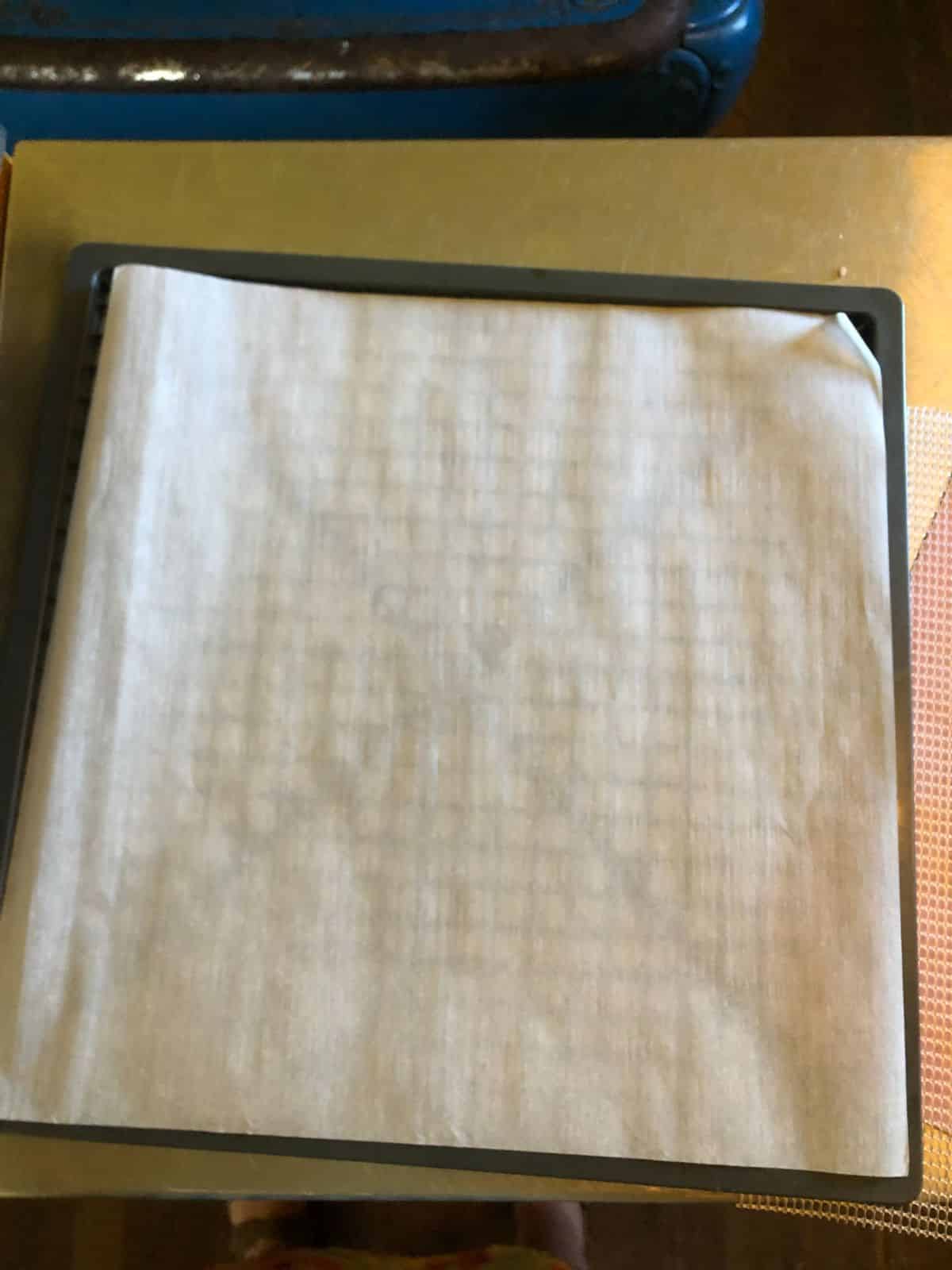
First, prepare the solid dehydrator liners or cooking sheets. Baking sheets for the oven need to be lined with parchment paper. For dehydrator trays, you can use a solid tray liner, silicone liners, or parchment drying sheets.
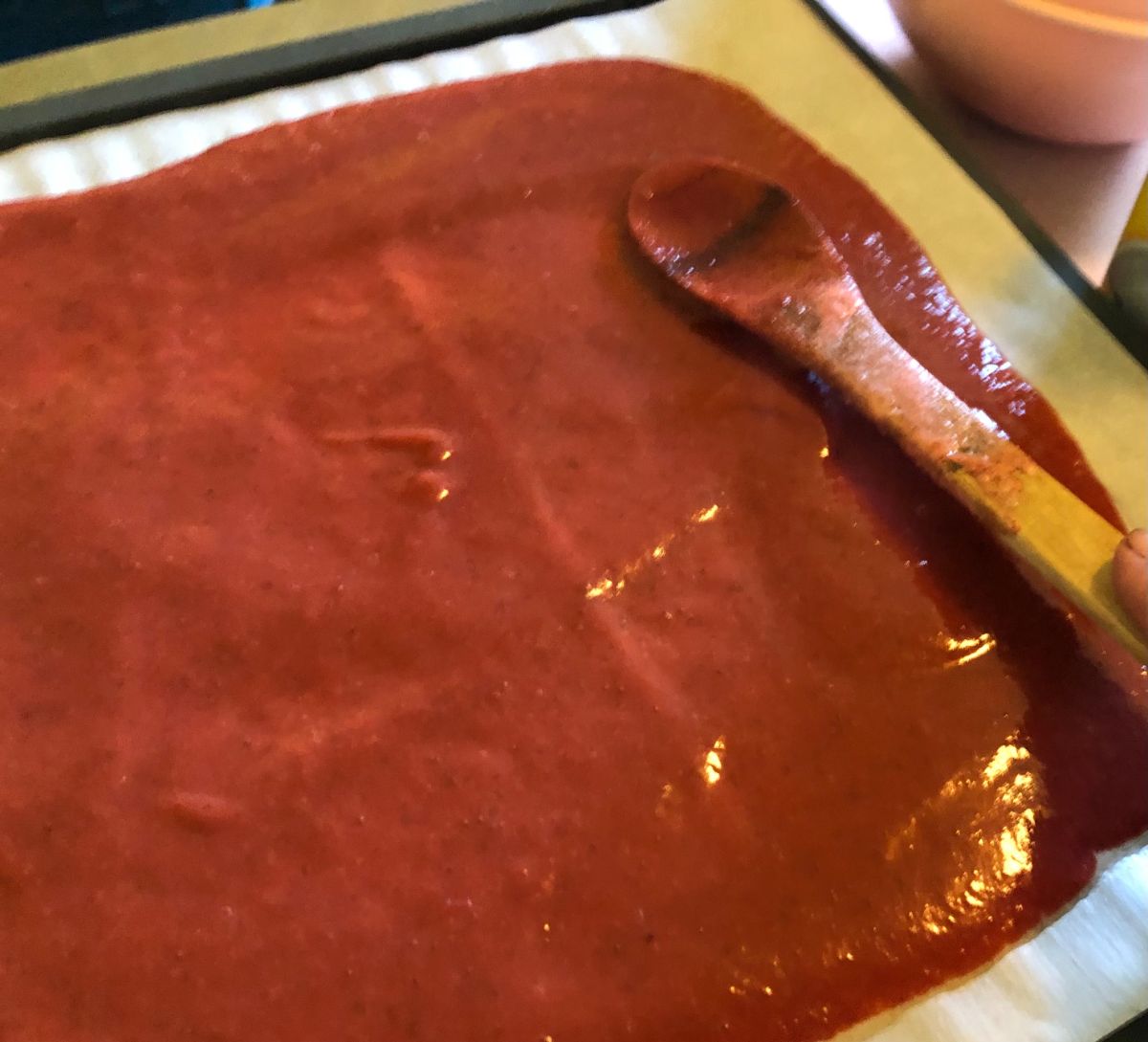
- Spray the sheets or liners with a light coating of oil-based cooking spray
- Spread the puree evenly over the entire liner
- Spread the puree to a thickness of ¼ inch thick
- Avoid making thick and thin areas—spread evenly
- Make sure there are no empty spaces or holes in the puree
- Lightly tap the tray to release air bubbles
Dehydrate the Strawberry Puree
A home dehydrator is best for making dehydrated fruit leathers. If you do not have one, an oven will work, but you’ll have to watch more closely because ovens will not go as low as dehydrators, and sometimes the oven will cook the leather rather than dehydrate it.
In a dehydrator:

- Place the prepared trays of puree in the dehydrator
- Set the drying temperature to 135 F (57 C)
- Dry for 8 hours or until done
- Rotate the trays after 4 hours
- Check for doneness after 6 hours
- For better and faster, more complete dehydrating, peel the entire sheet off the liner when it is almost done, then turn it over back onto the liner and continue to dehydrate. This is not completely necessary, but it does help to finish moister, thicker spots and helps the bottom side to dry thoroughly.
- If leather is not dried after 8 hours, continue to dehydrate until done (see tips below)
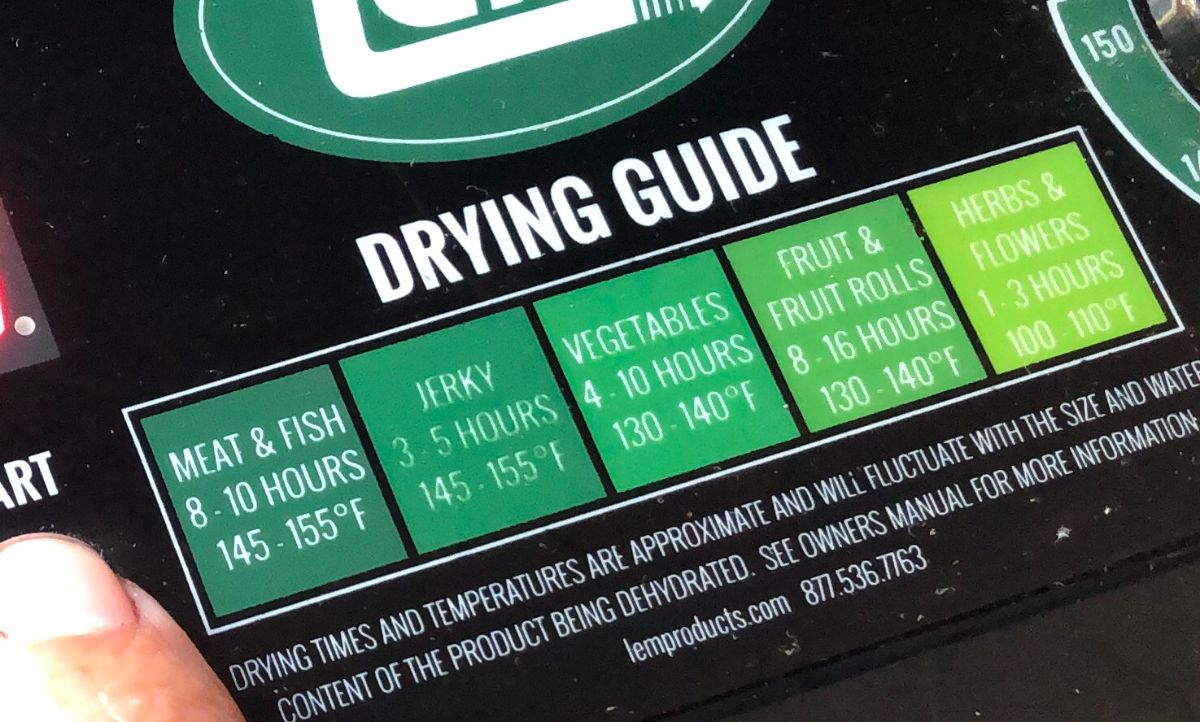
In the oven:
- Turn on your oven to 170F (76C). If your oven has a lower temperature, it is best to use it—down to as low as 135F/57C.
- Dry for 3 hours, turning and rotating the sheets after 1 ½ hours
- Lower temperatures will extend drying time to as much as 8+ hours but result in a more flexible, drier product
- Continue to dry in the oven until done (see tips below)
Cool and Store Your Strawberry Fruit Leathers
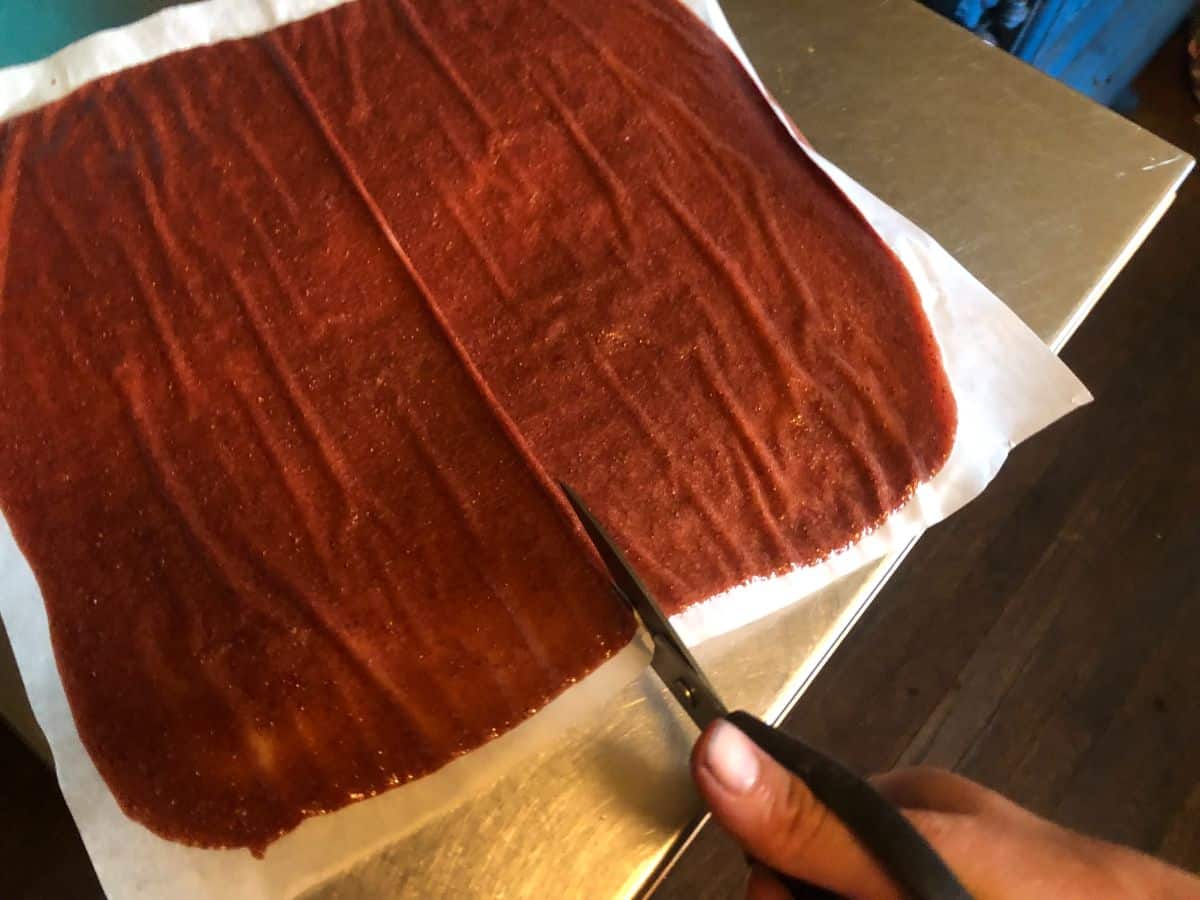
After dehydrating your fruit leathers, let them cool to room temperature, then cut them into desired sizes (any size you like) and then store them. Here are some tips and storage options:
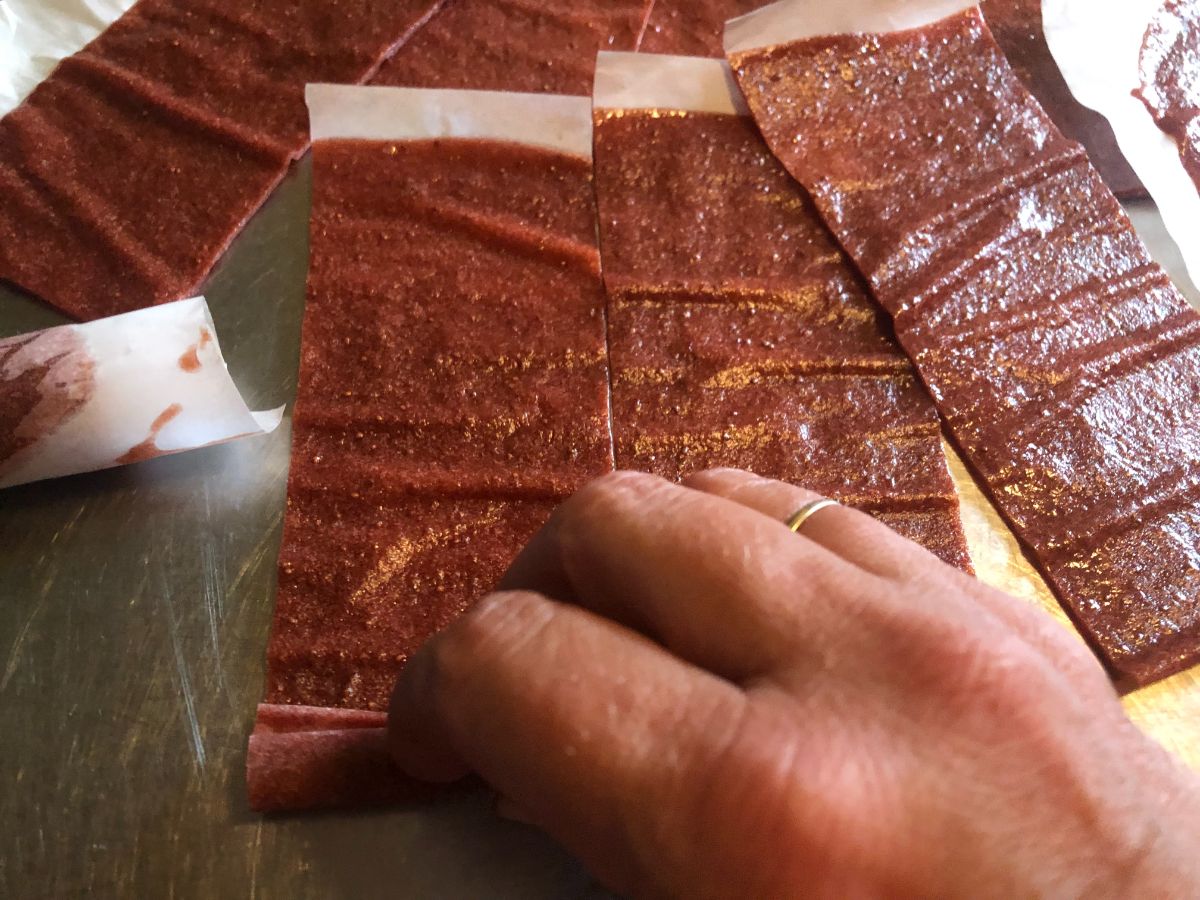
- If you used parchment paper, you can leave the leather on the paper backing and cut through both the strawberry leather and the paper. The paper will act as a backing when the fruit leathers are stored.
- Cut leather into strips and roll them up. Twist in plastic wrap for individual storage and twist the ends closed.
- You can roll leathers and store them without wrapping them if you put them in an airtight container or canning or mason jar.
- Oxygen absorbers will help preserve the flavor and dryness of the fruit leathers.
How to Tell When Your Strawberry Fruit Leather is Done Drying
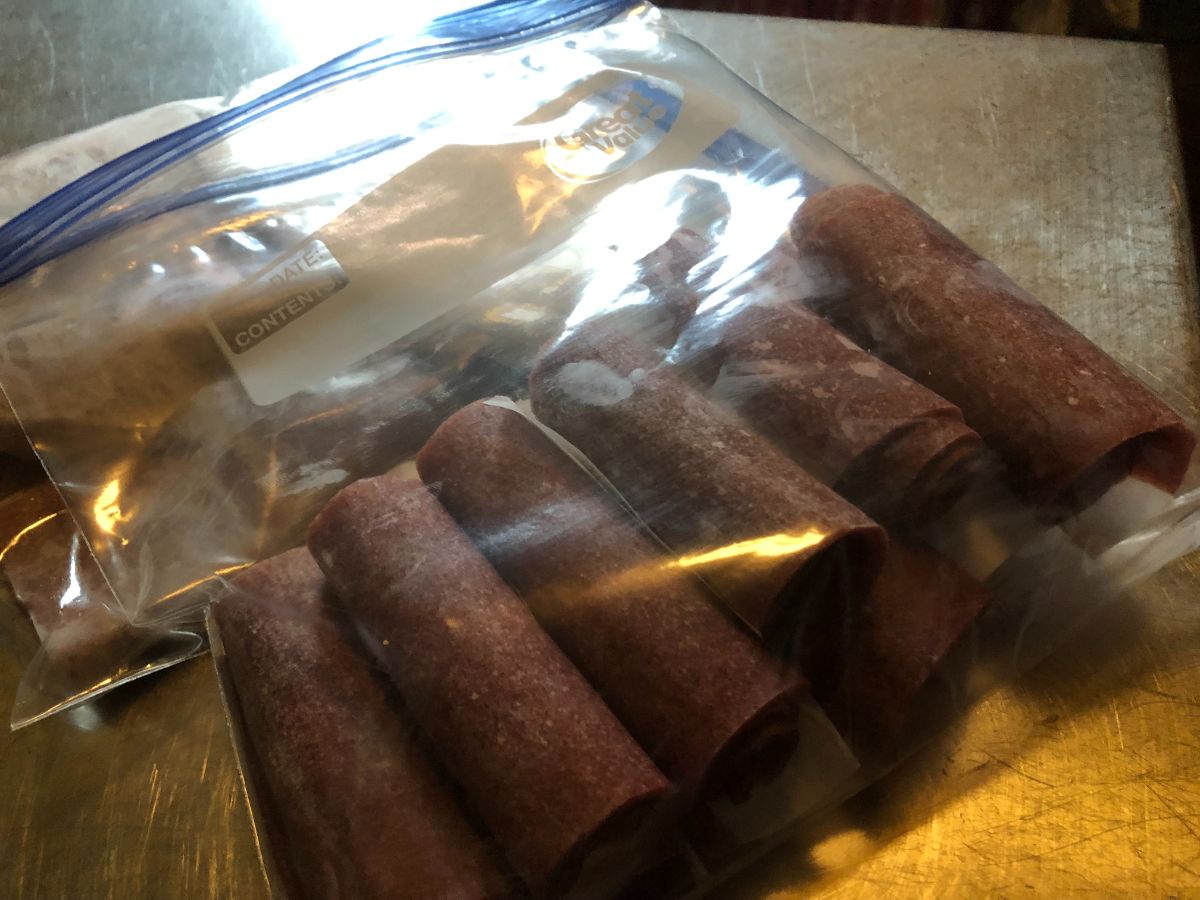
Drying or dehydrating is not an exact science. Many things can change the amount of drying time fruit leathers need, so you need to check and gauge the doneness of your leathers. The moisture content of the fruit, air humidity, and your oven or dehydrator can all impact the drying time for your homemade strawberry roll ups.
These tips will help you know when your fruit leather is dried:
- Fruit leather is dull in color
- Leather has no shiny, wet patches
- Leather is not sticky to the touch, though a light tackiness is normal
- Fruit leather is flexible and bends easily
- Dried fruit leather will peel easily off the sheet or backing
If the leather is crispy or breaks when you bend it, it is over-dried. It is fine to eat but not as enjoyable. If your leathers are starting to get brittle, stop drying them.
Fruit leathers dry from the outside edges to the middle. Thicker spots, however, may take longer to dry. Dry until all areas of the strawberry leather are dried properly.
Other Flavors You Can Combine with Strawberries in Fruit Leather
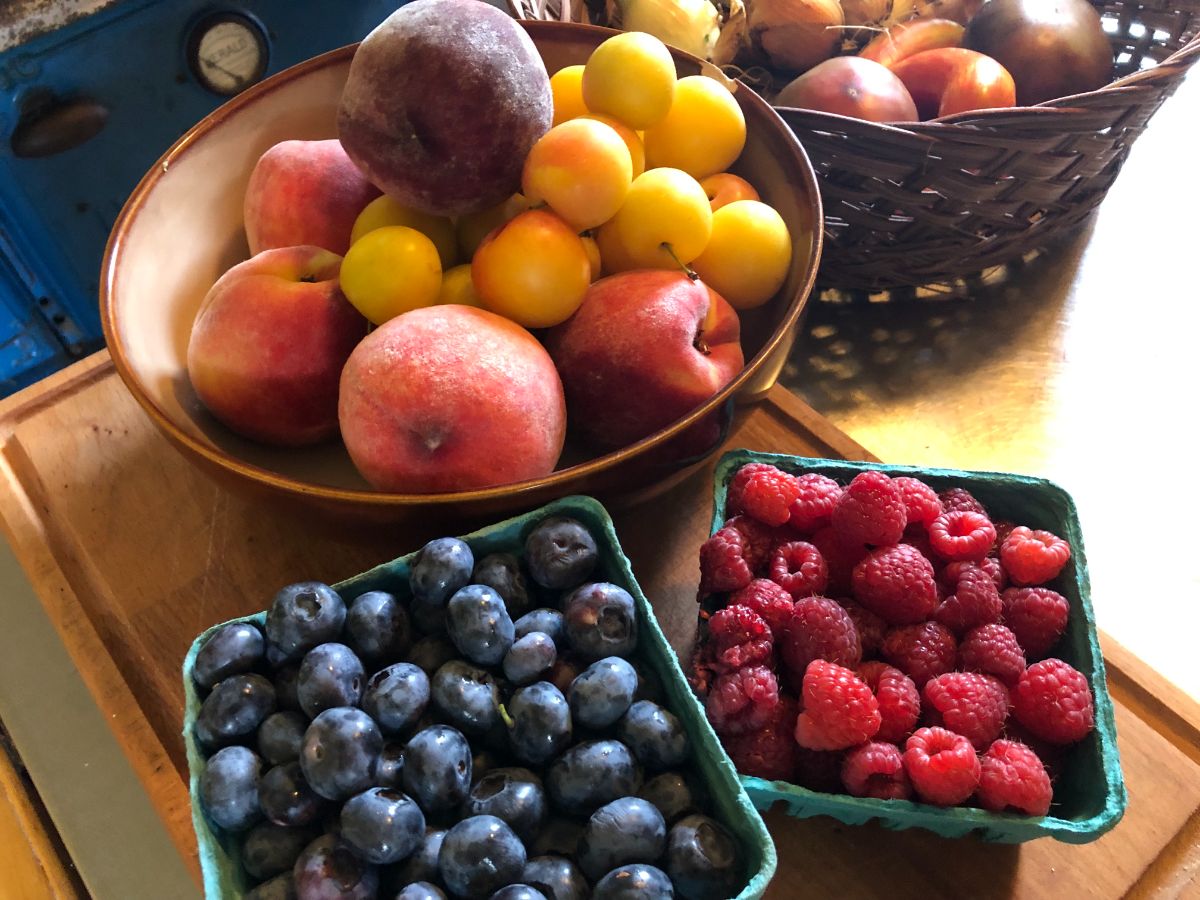
- Rhubarb – Strawberry-Rhubarb makes a delicious strawberry puree, but you will need to cook the puree before drying so the rhubarb strings break down smoothly. Use half strawberries and half rhubarb and increase the sugar to 2/3 to ¾ cup or to taste. Put the strawberries and the chopped rhubarb in a saucepan with the sugar, stir to combine, heat to simmer, and cook for ten minutes over medium heat. Stir often while simmering. Cool for a few minutes, then transfer to a blender or food processor to blend.
- Mixed berries like strawberries with raspberries, blueberries, blackberries, or other soft fruits. These can be made without cooking the puree. Use any combination to make up the four cups.
- Strawberry Banana – substitute one-quarter to one-half berries with banana. No need to cook this puree. Adjust sugar to taste. Banana leathers are better if stored in the refrigerator.
- Apples or applesauce – applesauce is often combined with other fruits to make fruit leathers and dehydrated products. It adds a good structure to the leathers.
Summarized Strawberry Fruit Leather Recipe:
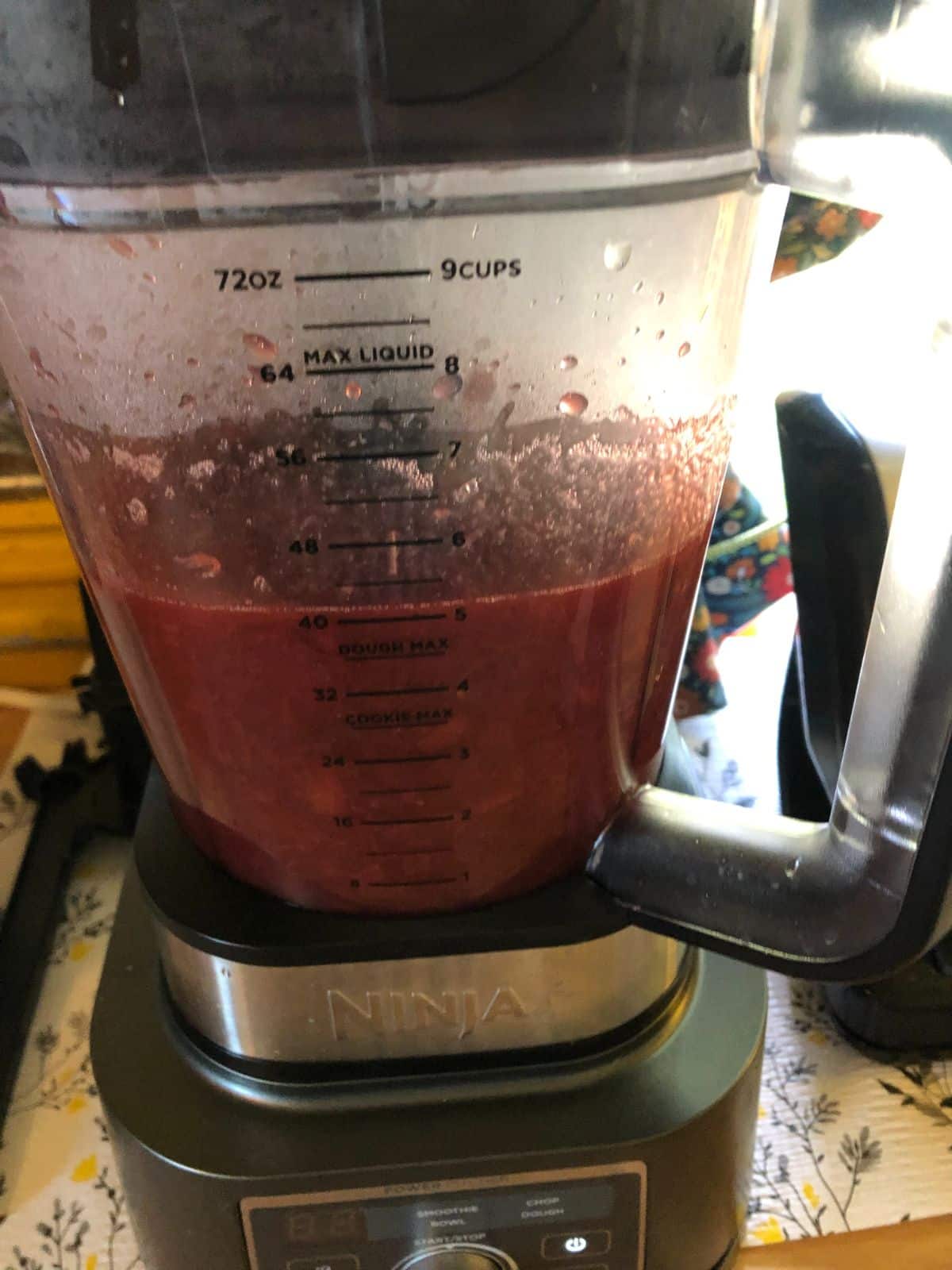
Ingredients:
- 4 cups prepared strawberries, trimmed and halved or quartered
- ½ cup sugar or honey, or to taste
Instructions:
- Put the prepared berries in a blender or food processor.
- Puree until smooth and uniform and no chunks remain.
- Add the sugar and blend until combined and evenly mixed.
- Spread the puree out about ¼ inch thick on a solid liner, silicone mat, or parchment paper-lined tray (or baking sheet if drying in the oven).
- Dehydrate for 6 to 8 hours, turning the tray or baking sheet halfway through. (Dry for about 3 hours in the oven at 170F or 76C).
- Fruit leather should be smooth and flexible when dried and should not have any wet or sticky spots. It will be darker and duller in color than the puree. It will be slightly tacky. Test the sheet in the center of the leather. Properly dried fruit leather will peel easily off the tray or backing.
- Let cool, then cut and wrap to store, or roll pieces and store together in a mason jar (preferably with an oxygen absorber).
- Enjoy!
Homemade Strawberry Fruit Leather Recipe
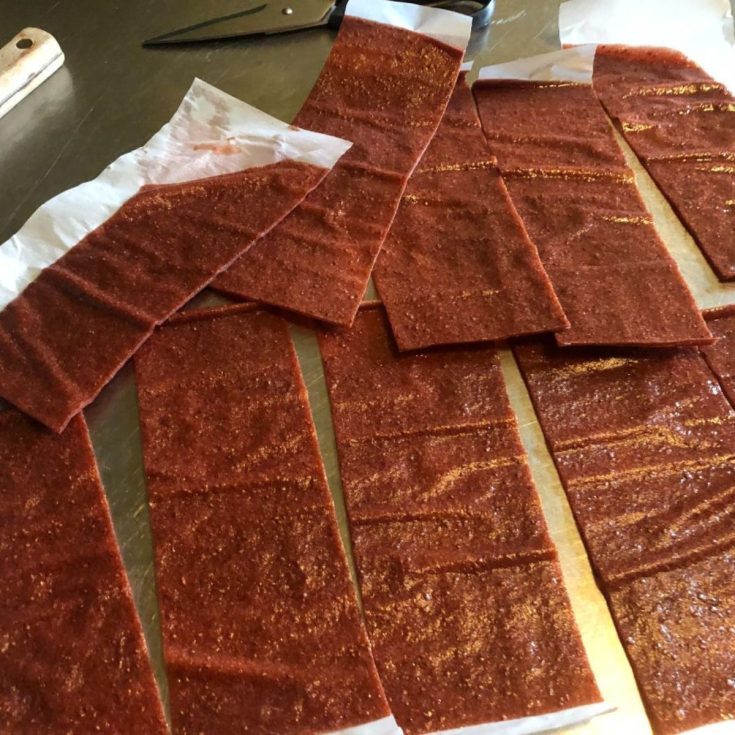
Craving a sweet treat? Whip up a batch of homemade strawberry fruit leather with this simple recipe. It's the perfect guilt-free snack!
Ingredients
- 4 cups fresh or frozen strawberries
- ½ cup sugar* or honey; use more or less to taste**
- 1-2 tablespoons lemon juice (optional—adds acidity that supports flavors and is an added protection in storage against pathogens, color loss, and flavor loss, but is not necessary)
Instructions
- Put the prepared berries in a blender or food processor.
- Puree until smooth and uniform and no chunks remain.
- Add the sugar and blend until combined and evenly mixed.
- Spread the puree out about ¼ inch thick on a solid liner, silicone mat, or parchment paper-lined tray (or baking sheet if drying in the oven).
- Dehydrate for 6 to 8 hours, turning the tray or baking sheet halfway through. (Dry for about 3 hours in the oven at 170F or 76C).
- Fruit leather should be smooth and flexible when dried and should not have any wet or sticky spots. It will be darker and duller in color than the puree. It will be slightly tacky. Test the sheet in the center of the leather. Properly dried fruit leather will peel easily off the tray or backing.
- Let cool, then cut and wrap to store, or roll pieces and store together in a mason jar (preferably with an oxygen absorber).
- Enjoy!
Notes
- Sugar is optional. It is used only as a flavoring and sweetener. If you don’t like added sugar or have dietary reasons to restrict your sugar intake, you can leave the sugar out. Strawberries do concentrate in flavor and sweetness while they dry, so leaving out the sugar is often of little or no account.
- Strawberries, like any fruit, can vary in sweetness, so it’s best to start low and add more sugar. Taste a berry before you start, and if it is very sweet, cut back on the sugar. If berries are tart or bland in flavor, you’ll probably need more sugar. Taste the puree before you spread it on the liners and adjust if needed. Keep in mind that the flavors will concentrate as the strawberry leather dries, so err on the side of under-sweet rather than over-sweet.
- A home dehydrator is best for making dehydrated fruit leathers. If you do not have one, an oven will work, but you’ll have to watch more closely because ovens will not go as low as dehydrators, and sometimes the oven will cook the leather rather than dehydrate it.

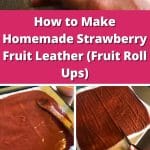
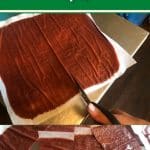
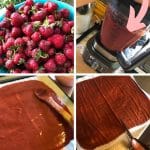





Leave a Reply